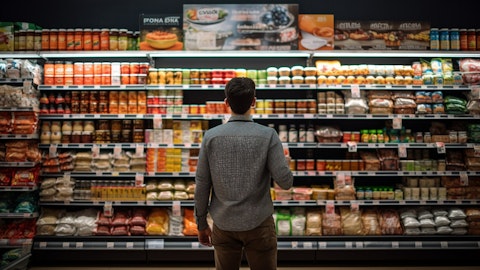But in the short term, it will probably be around the levels that we mentioned. I think that answers most of the questions. Fernando, maybe a few words on the Prestige Beauty side that you…
Fernando Fernandez: Yes, of course. Pleasure. First of all, I would like to say Prestige Beauty and Health & Wellbeing now, they will represent — they represent already 27% of our turnover in the Beauty & Wellbeing business groups. Both pillars, both Health & Wellbeing and Prestige Beauty have been growing at mid-teens. And if you look at our top 5 brands, Liquid I.V., Nutrafol, [indiscernible] Dermalogica, Paula’s Choice, Hourglass, all of them grew double-digit both in the year and in the fourth quarter. So really, really strong performance. I would say that behind the success of these brands — I would say some of the pillars behind the success of these brands are exactly the same that Hein has laid out for the Growth Action Plan.
We are shifting resources to the most profitable brands and we are increasing exposure to premium segment, to fast-growing channels, to the United States and we are optimizing through portfolio bolt-on acquisitions like this one that really give us a very good exposure. K18, we have just completed the acquisition on the 1st of February. Very, very exciting brand, just anchoring the intersection between biomimetic science are a very strong social engagement program, a very, very strong presence in TikTok. And we are very, very excited about the growth prospects that this brand bring into the company with an excellent founder that has put together a very, very solid company and a very solid management team. We are sure that we can add, as we have done in all the Prestige Beauty and Health & Wellbeing, a lot of science into these brands to really boost our innovation program.
In terms of competitiveness, I would like just to highlight a couple of things. Our intention today was fundamentally to tell you 3 things: we measure share in about 70% of our turnover. What is not included there, it is not included because there is no reliable measurement because the metrics in the — are not reliable in terms of coverage. Businesses that are not included there include some of our fastest-growing businesses like Prestige Beauty, Health & Wellbeing and Food Solutions. And you can see that basically in the difference of underlying sales growth between the business we measure and the business we don’t measure. The second thing to say is that our organic sales growth compared favorably with the global market growth, what highlights the attractiveness of our category and our geographical footprint.
And the third thing and probably the most important is that we are disappointed with our competitive performance in the footprint in which we operate. We will use turnover-weighted share to measure our performance going forward fundamentally for 2 reasons: it gives a clear indication of the gap between organic sales growth and turnover-weighted market growth; and it takes into account differently to what’s happening with business winning metric, the depth of the share gains and the share losses. So just to reaffirm that we are not happy with our performance in terms of competitiveness. It’s a burning platform for both Hein and myself, and we will really attack decisively on that.
Unidentified Company Representative: Our next question comes from Celine at JPM.
Celine Pannuti: So my first question would be to understand what happened in the volume growth in Lat Am, which was quite strong, 9%, and as well in the U.S. So if you could shed some light because those are — for those 2 markets, it’s well above, I think, the market growth. So could you explain that, and trying to understand whether there were some one-off factor or what kind of sustainability of volume we should be looking for these regions. And then my second question is a bit to come back to some of the questions, frankly. First, on cost, you said that cost is still positive 2% to 3%. Could you kind of help me understand that because if I look at your — many of your raw material, I see them being down quite a lot. Yes, food are up, but a lot of the oil derivatives, edible oil and so on and so forth are down a lot and that’s why you were mentioning that price slowing down in some emerging markets.
So yes, I find it a bit difficult to understand how it’s not flat or even negative for the year. And then maybe as well a follow-up on that price-versus-volume equation. Are you signaling that pricing will continue to decelerate fast, and I think we are facing peak pricing in H1 of ’23. And I was wondering whether that means that — what it means in terms of elasticity of volume if I see some regions like Asia, where price comes down, volume is up 2% in India, but it’s hardly up a lot. So just want to understand a bit that equilibrium of price versus volume. I know you had been asked, but it’s a bit unclear to me.
Hein Schumacher: Thank you, Celine. I mean very clear 3 questions. So first of all, on the volume growth in the U.S. and in Latin America, so a couple of words on those. Of course, we are implementing the action plan with enormous speed and decisiveness. And I first want to point out that a number of the trends that we’re seeing in the U.S. and Lat Am are, in that sense, a good inspiration for what should happen across the globe. I mean, first of all, we’re seeing strong expansion of the Prestige Beauty and the Health & Wellbeing space. And Fernando just talked about that, Warren asked the question about it, that is about 1/4 of the U.S. business. And that’s all been double digit. And of course, that helps on the total U.S. side.
Secondly, we have been implementing strong innovation in both North America as well as in Latin America and particularly around Deodorants, which has been growing double digit for us actually globally, but very much spurred by the development in the Americas. And that is all behind the protection — 72-hour protection behind some of our core brands. And once again, we’re using that technology but we’re applying it to Dove, we’re applying it to Rexona, to Sure, et cetera, et cetera. So strong performance in Deos. But also premiumization. We’re landing at this point premiumized portfolios in Dove, but also in our Nutrition portfolio. I was very pleased when visiting Latin America recently on Brazil, very good performance on Hellmann’s where we introduced a premium mayonnaise products, but also line extensions in other mayo-based sauces.
So I think all of these things come together, premiumization, good innovation and then, of course, the growth in our Prestige and Health & Wellbeing businesses. Those are the most important reasons behind it. Is it structural? Look, these type of growth rates, volume growth rates, are hard to maintain forever, of course, but we’re seeing a good momentum in the Americas and we’re pleased with that, and we’re keen to benefit from that globally. If you look at it from a cost perspective, the 2.5% and 3% or sort of that I pointed at, you are right. In the short term, there are some — it’s probably for the company a bit more flattish. So the prediction for the year that I gave is — might be a bit more towards the balance of the year we see inflation picking up.
I already talked about India, where we believe there will be some happening going forward. But at the same time, there are, of course, also ForEx impacts here from transactional ForEx, for example, that is also not always playing to — well, you simply buy in the emerging markets a bit more expensive and that has some headwind that needs to be offset and that will lead to some cost-in. Look, I mean, if you look at pricing, is there a fast deceleration? I mean, I don’t think we’re saying that. I mean, as I said, in some areas in the world, we are adapting our pricing. We’re seeing additional promotional activity. I already talked about the examples. India, we talked about minus 2% and then plus 2% on volume. Southeast Asia, to some extent, we’ve significantly increased our efforts to get — to become more competitiveness on, for example, Ice Cream in North America.
So those are the tactical things we’re doing but I wouldn’t point yet to a fast deceleration on pricing.
Fernando Fernandez: Yes, I would add only that, of course, the price deceleration has been higher in categories of low — of high elasticity like in-home Ice Cream or laundry or skin cleansing bars. So that’s one important point. The other point that I feel is important is we don’t see — we don’t expect negative pricing for the whole group. It can happen in some of our categories.
Unidentified Company Representative: Our next question comes from Fulvio at Berenberg.
Fulvio Cazzol: My first one is on the Power Brands growth of 6.5%, as you stated, in Q4, which implies that the rest declined slightly. I was wondering if you are seeing any cannibalization effects benefiting the Power Brands as you redirect investments there? Or is there limited market overlap between the top 30 brands and the rest? And then my second question is on CapEx. I’m just trying to understand how you can spend only 3% of sales, which you previously guided to anyway, of which half will go towards productivity and you also expect to generate higher volume growth. Is there capacity — is capacity utilization in Unilever low? Or do you expect it to reduce SKUs and simplify operations? I mean, could that explain the low CapEx spend relative to your peers?
Hein Schumacher: Thanks, Fulvio for your 2 questions. I mean, first of all, on Power Brands and we laid it out in the speech, so I mean it’s very important to reemphasize we are not neglecting brands outside of the top 30. And it’s not that the — with the 6.5% that the other ones are in decline. What we’ve said with the top 30 proposition was we are directing our funds, first and foremost, behind those Power Brands to place bigger bets behind multiyear and scalable innovations. We also want to make sure that the superiority framework that we talked about and the brilliant execution around that is — that we measure that consistently and very well for the top 30 Power Brands because that will ensure brilliant execution in the company.
It will just make it better than when we declare that — all of that for all of our brands. We just want to make sure that we face and pace that well, and we feel that we’re well underway with our Power Brands, now 75% of the total company and with accelerated growth. And I’m sure some of the other strong brands beyond the top 30 they will on pretty fast through the themes that we talked about. Actually, I mean, if you think about the capital expenditure and the productivity agenda, we have guided towards an increase in capital expenditure from 2.7% that we had last year to somewhere between 3% and 3.5% for 2024. So we are stepping up capital expenditure, that’s number one. Secondly, within the capital expenditure bucket, we’re looking for a greater spend on productivity.
Productivity was a very important part of the Growth Action Plan and historically we’ve just spent less on that, so we’re going to spend more and a greater percentage of the total CapEx amount on productivity. We’re seeing good opportunities there to reduce controllable costs.





